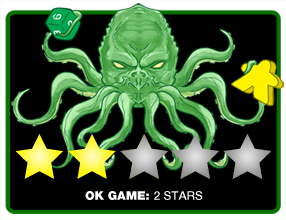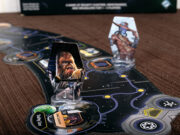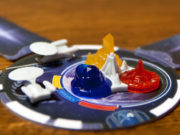 As nerdy (OR AWESOME editor’s note: definitely nerdy) kids growing up in the 90s, on weekends my friends and I would venture to a magical establishment called the Route 18 Flea Market where would procure limited edition action figures, vintage Star Wars toys, and copyright infringed video games and anime. For a while, our holy grails were new VHS tapes with dubbed episodes of the Dragon Ball Z (DBZ) anime that were not officially released in the US at that point. The tracking was usually off and very rarely were the episodes in any sort of a logical order, but it was special because in our corner of samey-same suburbia, we created a secret DBZ fandom (sounds a bit like board games 20 years later).
As nerdy (OR AWESOME editor’s note: definitely nerdy) kids growing up in the 90s, on weekends my friends and I would venture to a magical establishment called the Route 18 Flea Market where would procure limited edition action figures, vintage Star Wars toys, and copyright infringed video games and anime. For a while, our holy grails were new VHS tapes with dubbed episodes of the Dragon Ball Z (DBZ) anime that were not officially released in the US at that point. The tracking was usually off and very rarely were the episodes in any sort of a logical order, but it was special because in our corner of samey-same suburbia, we created a secret DBZ fandom (sounds a bit like board games 20 years later).
When IDW announced that they would be releasing Dragon Ball Z: Perfect Cell, I was immediately intrigued. Would this be a Goku and Piccolo learn to drive filler game or would it score over 9000? Luckily for you, I made the ultimate sacrifice so that you don’t have to.
Dragon Ball Z: Perfect Cell is a cooperative dice rolling game. It plays 1 to 4 players, but is best with 4 players and takes about 45 minutes.
Gameplay Overview:
Dragon Ball Z: Perfect Cell pits the Z-fighters against Cell in his perfect form, with the object of the game being to reduce Cell’s health points to 0. Players start the game by picking one of the Z fighters; Goku, Gohan, Vegeta, Krillin, Trunks or Piccolo. Each fighter has their own special ability which ranges from re-rolls, to assisting other fighter rolls, to starting with or discounting power up upgrades.
Each round is divided into three phases:
- New Threats – where threat tiles will be revealed.
- Z-Fighter Turns – where players roll dice and allocate specific die faces to reduce Cell’s health points with regular attacks or power-up attacks; disable Cell’s threat tiles; or heal other fighters.
- Cell Activates – where all active threat tiles activate which deal damage to the players, heal Cell’s health points, and/or nullify certain faces of the die.

Game Experience:
I was always told that if I don’t have anything nice to say, I shouldn’t say anything at all. I tried to explain this to my publisher here at Board Game Quest, but he was having none of it. Some people just ain’t raised right. So now here I am, trying to find a way to describe my game experience without saying “just buy King of Tokyo,” or “have tried The Reckoners yet?”. Let’s see how this goes.

Since it has been over 23 years since its air date, and I assume that you have access to the internet, I don’t feel particularly bad about spoiling anything here. In the classic anime, Perfect Cell was a very real threat to the Z-Fighters and was the third form of the villain. The first two forms being (drumroll please) Imperfect Cell and uhh… Semi-Perfect Cell (of course). In his Perfect (least bug-like and most human-like) form, Cell is responsible for the death of several Z-Fighters (some a few times over), all the inhabitants of King Kai’s Planet, our one true hero Goku, and nearly planet Earth. This rather long winded point is that Perfect Cell should be a challenge to players. Players should barely escape with their sweaty die filled hands, but frankly the game never hits the mark. Since this is a game that will generally only attract DBZ fans, players will be familiar with the source material. In other words, you can’t miss by this much and expect to have it go unnoticed.
The long and short of the game is that players will roll their dice (5 each) and allocate faces to accomplish certain goals. The most challenging of the threat tiles (red visor tiles) will depict how much damage players will take each turn. On their turn, Z-Fighters play simultaneously while allocating their die rolls. The special abilities of the Z-Fighters do well to mitigate most of the randomness and threats are generally overcome a turn or two after they show up.

Players familiar with modern hobby board games will quickly be able to work out an order of priorities and make short work of any threats posed. The power-up upgrades, which can easily (and inexpensively) be purchased with the same die rolls, serve to make make Cell more manageable. Even with Cell starting with 70 health points and players with their default 5 or so, the Z-players won – every time. Roll, rinse, repeat.
Though gameplay is nothing to write Gohan about, I should give credit where credit is due. The components in the game are rather simple and more blank space than informative, but aesthetically there is absolutely no doubt that each and every piece of cardboard in this box belongs to a Dragon Ball Z game. The fact that the threat tiles are visors (google “over 9000” for the uninitiated), life points are senzu beans, and the playable Trunks Z-Fighter is Future Trunks, all lend themselves to the fact that whoever made the graphic design decisions here, lead with theme and filled in the empty space with dice rolling afterwards.
Unfortunately, this could have been literally any theme. Beyond a nice piece of memorabilia or a way to fill out the collection of the “DBZ Fan in your life who has it all,” I’m not entirely convinced this needs to be in any gamer’s collection.
Final Thoughts:

In the end, this errs more on the side of learn-to-drive than Goku’s Sacrifice and no this certainly does not score over 9000. It is unfortunate and I was frankly a little disappointed in Dragon Ball Z: Perfect Cell. After nearly 20 years since my last hunt through a dusty flea market for some imported treasures, I was hoping for a nice walk down memory lane. Instead, I got some custom dice and 45 minutes of gameplay that I would be hard pressed to choose over another game in my collection.
How old is this fan base at this point? The Perfect Cell story arc is almost a quarter century old. Was a hobby board gamer level challenge too difficult or too narrow for the IP? The game should have been packaged in a box a quarter of the size, with a track instead of a board and billed as a filler game. In all honesty, what Dragon Ball Z: Perfect Cell tries to do with dice, was already done (and better) several times over by this point.
Need a good gateway dice game? Pick up King of Tokyo. Want a meatier mid-level dice game? Pick up The Reckoners. Want a good Dragon Ball Z board game? Unfortunately, you are going to have to look somewhere else. This one just misses the mark.
Final Score: 2 Stars – Kameha…meh…
 Hits:
Hits:
• The artwork is well done.
• Smart nods to fans of the series.
• Not too complex to play right out of the box.
Misses:
• Lacks depth
• Not overly challenging
• Gameplay mechanisms have already been done better elsewhere and by others.






















